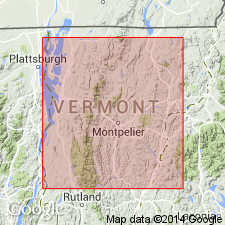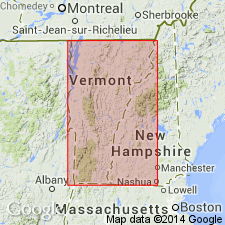
- Usage in publication:
-
- Calais granite
- Modifications:
-
- Original reference
- AAPG geologic province:
-
- New England province
Summary:
Table opp. p. 288. Calais granite. Listed this name in Devonian of "central Vermont," but without definition. Quarried at Calais, Calais Township, Washington County, northeastern Vermont, in quadrangle adjoining Montpelier quadrangle on east.
Source: US geologic names lexicon (USGS Bull. 896, p. 314).

- Usage in publication:
-
- Calais Granite
- Modifications:
-
- Age modified
- Geochronologic dating
- AAPG geologic province:
-
- New England province
Summary:
Radiometric age dating on Calais Granite yields ages of 405+/-8 and 385+/-8 m.y. Therefore, the age of the rock is Devonian (post-Silurian and pre-Late Devonian).
Source: GNU records (USGS DDS-6; Reston GNULEX).
For more information, please contact Nancy Stamm, Geologic Names Committee Secretary.
Asterisk (*) indicates published by U.S. Geological Survey authors.
"No current usage" (†) implies that a name has been abandoned or has fallen into disuse. Former usage and, if known, replacement name given in parentheses ( ).
Slash (/) indicates name conflicts with nomenclatural guidelines (CSN, 1933; ACSN, 1961, 1970; NACSN, 1983, 2005, 2021). May be explained within brackets ([ ]).

